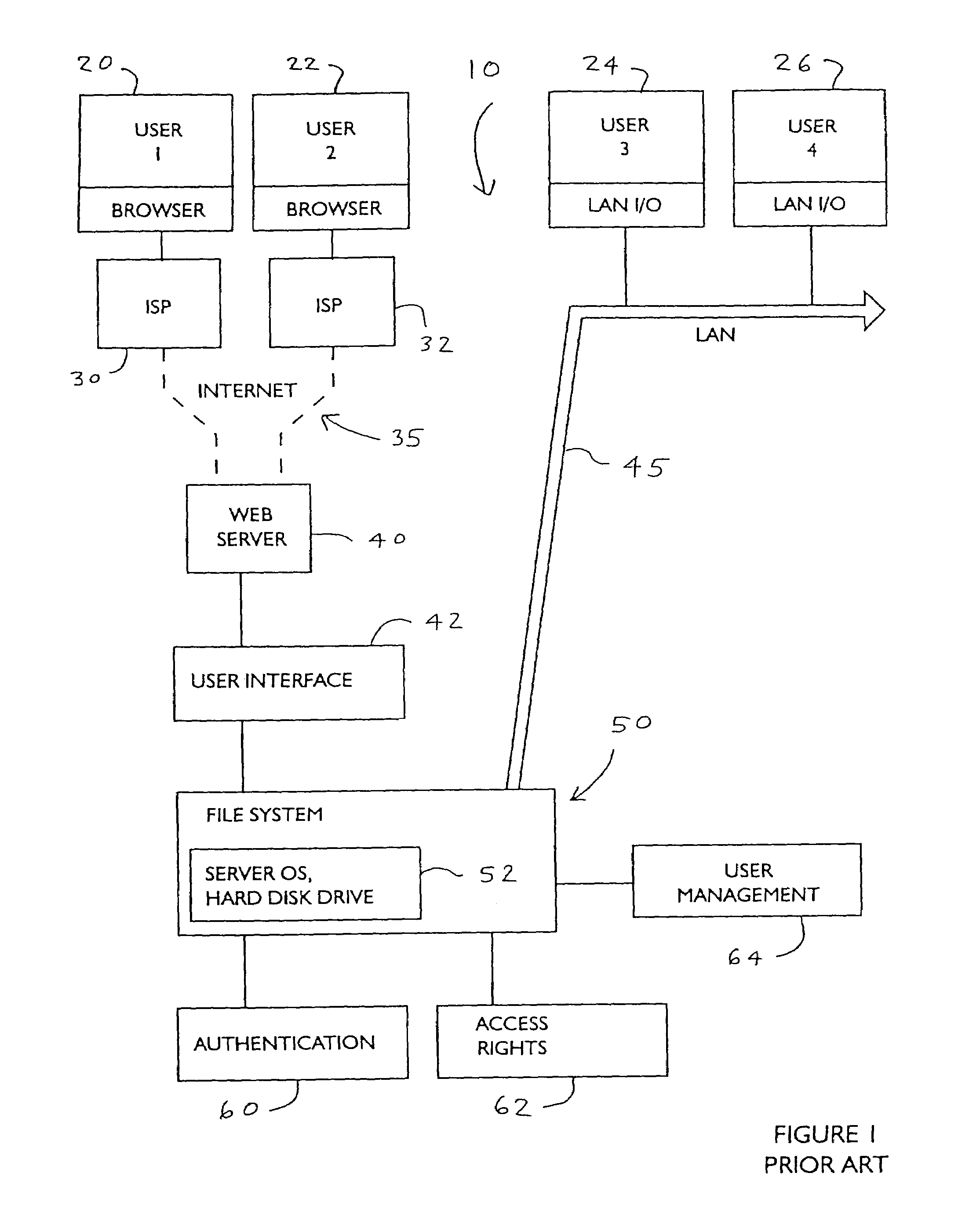[0013]Accordingly, it is a primary
advantage of the present invention to provide a
distributed file system that allows access to files by remote authorized users, and upon such access provides an Automatic Notification message to predetermined users having an appropriate interest in that particular file. It is another
advantage of the present invention to provide a distributed filed
system that is web-based so as to allow remote users to use standard
web browser software to access files in a central active
virtual file system, and upon such accessing, the active virtual file
system provides an Automatic Notification message to predetermined users having an appropriate interest in that file. It is a yet further
advantage of the present invention to provide a web-based active virtual file system that allows remote users to access certain files, and upon such access triggers an Automatic Notification message to other predetermined users having an appropriate interest in that file. It is still another advantage of the present invention to provide a web-based active virtual file system that can be configured to run programs, enforce constraints, send notifications, and perform other functions using predetermined rules that enable the active virtual file system to be used in
workflow automation. It is yet a further advantage of the present invention to provide a web-based active virtual file system that can be programmed by the systems administrator to accomplish tasks needed for E-commerce and in setting up sophisticated
intranet and Internet solutions, in which the active virtual file system provides triggers that automatically notify predetermined users having an interest in files that are being uploaded to or downloaded from the active virtual file system.
[0014]Additional advantages and other novel features of the invention will be set forth in part in the description that follows and in part will become apparent to those skilled in the art upon examination of the following or may be learned with the practice of the invention.
[0015]To achieve the foregoing and other advantages, and in accordance with one aspect of the present invention, an improved computerized file system is provided that is accessible by users over
the Internet, or via a
local area network (LAN) or
wide area network (WAN).
The Internet users typically operate
personal computer platforms having a
web browser software program that communicates with an
Internet Service Provider (ISP), which launches the users onto
the Internet itself. On the other end of the Internet, a
web server located near the computerized file system of the present invention receives messages from the users, and transmits messages back to those users as they “logon” to the file system. The LAN users typically operate
personal computer or
workstation platforms that are directly connected to a
local area network (LAN), which in turn is connected into the
web server at the computerized file system's site. These LAN users will also preferably have a
web browser-type
software program that is in communication over the LAN with the
web server near the computerized file system of the present invention.
[0016]The web
server is connected to a
user interface that presents a “folder” window to the user, in the form of a
Java tree structure. The
user interface also is in communication with a web-based active virtual file system (which is also referred to as a “WAVFS”) that contains a network
server operating system, which includes at least one hard disk drive and a
database. It is preferred that all users, regardless of their particular physical communications link to the WAVFS platform, be able to access the active virtual file system of the present invention by use of a web browser resident on the users' own
computer platform. The WAVFS
operating system may operate as a stand-alone system, or may be resident on top of a different architecture, or on top of other applications running on the same computing platform.
[0017]When a user initially communicates to the WAVFS
distributed file system, it must be determined whether or not that user has any right to be logged into the file system. An “
Authentication” function makes this determination. Once the user has been properly authenticated, this user's access rights must now be determined, and the WAVFS uses an “Access Rights” function for this purpose, which inspects information previously stored in the WAVFS pertaining to this particular user. This information essentially determines whether or not a user has the right to either read or write, or both read and write, a particular file that already resides on the active virtual file system's hard disk drive. These access rights also determine whether or not a user will be able to upload a new file onto the hard disk drive of the WAVFS. Authorized users optionally can seamlessly encrypt their data when uploading files uploading files to the WAVFS.
[0018]Other functions that are available to the active virtual file system 150 include a “
User Management” function and a “Group Management” function, which allow the WAVFS systems administrator to add, delete, or edit users and their attributes (at the
User Management function), and to also group various users in predetermined ways (using the Group Management function). The
User Management and Group
Management functions also allow importing users / groups from other systems, such as
UNIX password / group files, or from other systems such as NIS, NT or Novell operating systems.
 Login to View More
Login to View More  Login to View More
Login to View More 


